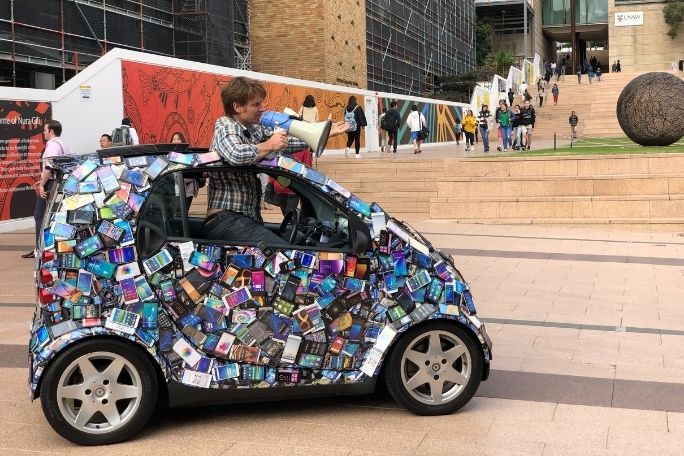Lesson summary
In this lesson, students explore the issue of plastic waste and its impact on our environment. They begin by participating in a silent gallery activity, viewing and responding to a range of images relating to plastic waste. Students then investigate one of these issues in detail and source or create a new image that helps to express their research. This image is then added to the gallery exhibit and students again reflect on the waste information being communicated.
Learning intentions:
Students understand...
- that plastic waste has a range of impacts.
Success criteria:
Students can...
- think critically and respond to visual prompts
- undertake research
- visually represent research findings
- participate in class discussions.
Lesson guides and printables
Curriculum links
Select your curriculum from the options below.
Lesson details
Curriculum mapping
Australian curriculum content descriptions:
Year 7 Geography:
- The influence of environmental quality on the liveability of places (ACHGK045)
- Evaluate sources for their reliability and usefulness and select, collect and record relevant geographical data and information, using ethical protocols, from appropriate primary and secondary sources (ACHGS048)
- Present findings, arguments and ideas in a range of communication forms selected to suit a particular audience and purpose; using geographical terminology and digital technologies as appropriate (ACHGS053)
Year 8 Geography:
- Ways of protecting significant landscapes (ACHGK052)
- Evaluate sources for their reliability and usefulness and select, collect and record relevant geographical data and information, using ethical protocols, from appropriate primary and secondary sources (ACHGS056)
- Present findings, arguments and ideas in a range of communication forms selected to suit a particular audience and purpose; using geographical terminology and digital technologies as appropriate (ACHGS061)
Year 9 Geography:
- The effects of the production and consumption of goods on places and environments throughout the world and including a country from North-East Asia (ACHGK068)
- Evaluate sources for their reliability, bias and usefulness and select, collect, record and organise relevant geographical data and information, using ethical protocols, from a range of appropriate primary and secondary sources (ACHGS064)
- Present findings, arguments and explanations in a range of appropriate communication forms, selected for their effectiveness and to suit audience and purpose; using relevant geographical terminology, and digital technologies as appropriate (ACHGS070)
Year 10 Geography:
- Human-induced environmental changes that challenge sustainability (ACHGK070)
- Evaluate sources for their reliability, bias and usefulness and select, collect, record and organise relevant geographical data and information, using ethical protocols, from a range of appropriate primary and secondary sources (ACHGS073)
- Present findings, arguments and explanations in a range of appropriate communication forms, selected for their effectiveness and to suit audience and purpose; using relevant geographical terminology, and digital technologies as appropriate (ACHGS079)
Syllabus outcomes: GE4-1, GE4-2, GE4-3, GE4-5, GE4-6, GE4-7, GE4-8, GE5-2, GE5-3, GE5-7, GE5-8.
General capabilities: Critical and Creative Thinking.
Cross-curriculum priority: Sustainability OI.7, OI.9.
Relevant parts of Year 7 Geography achievement standards: Students explain interconnections between people and places and environments and describe how these interconnections change places and environments. They evaluate a range of secondary sources to locate useful information. Students present findings and arguments using relevant geographical terminology in a range of communication forms.
Relevant parts of Year 8 Geography achievement standards: Students explain interconnections within environments and between people and places and explain how they change places and environments. They evaluate a range of secondary sources to locate useful and reliable information. Students present findings, arguments and ideas using relevant geographical terminology in a range of communication forms.
Relevant parts of Year 9 Geography achievement standards: Students analyse interconnections between people, places and environments and explain how these interconnections influence people, and change places and environments. They evaluate a range of secondary sources to select and collect relevant and reliable geographical information. They present findings, arguments and explanations using relevant geographical terminology in a range of appropriate communication forms.
Relevant parts of Year 10 Geography achievement standards: Students identify, analyse and explain significant interconnections between people, places and environments and explain changes that result from these interconnections and their consequences. They critically evaluate a range of secondary sources to select and collect relevant, reliable information. Students present findings and explanations using relevant geographical terminology and graphic representations and digital technologies in a range of selected forms.
This lesson is part of the wider unit of work: War On Waste – Years 7-10
Time required: 60 mins
Level of teacher scaffolding: High – source materials and prepare gallery
Resources required
- Device capable of presenting an online clip to the class
- Familiar plastic waste items found in bins at school such as plastic bottles, plastic straws, and plastic food packaging, containers and wraps
- Other plastic items that when discarded become waste, such as plastic kettles, phones or tablets with plastic parts, plastic torch, plastic toys, and clothes made of synthetic materials (such as polar fleece)
- Silent Gallery Images
- Student Worksheet – one copy per student
Skills
This lesson is designed to build students’ competencies in the following skills:
- Communication
- Creativity
- Critical thinking
Additional Info
Cool Australia’s War On Waste lessons have been developed in partnership with Lune Media and with support from the Australian Environmental Grantmakers Network. These lessons have been designed to lead students through a deeper understanding of some of the big issues relating to waste in Australia and to support them to take action to reduce the impact of waste on our environment.


Welcome back!
Don't have an account yet?
Log in with:
Create your free Cool.org account.
Many of our resources are free, with an option to upgrade to Cool+ for premium content.
Already have an account?
Sign up with:
By signing up you accept Cool.org's Terms and Conditions(Opens in new tab) and Privacy Policy(Opens in new tab).